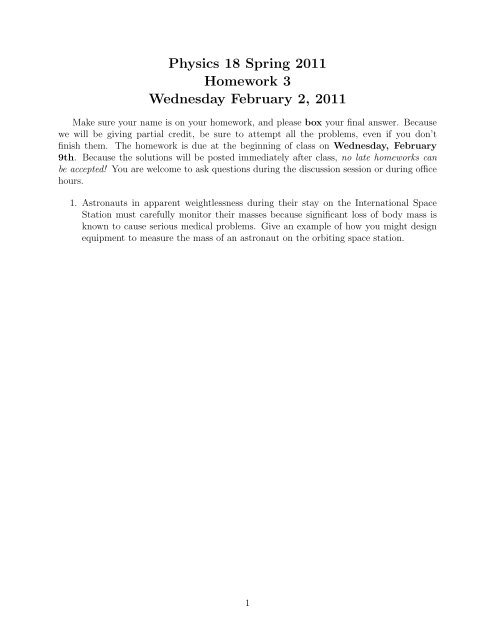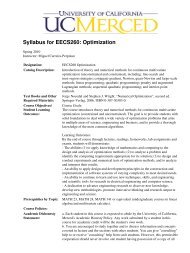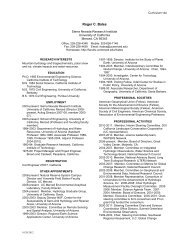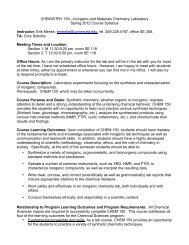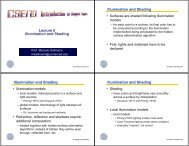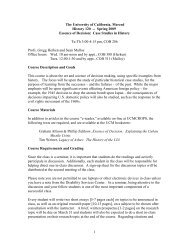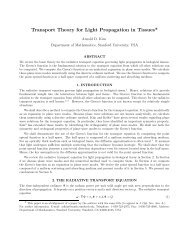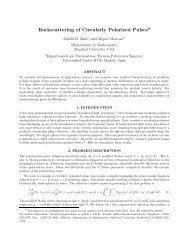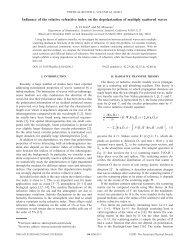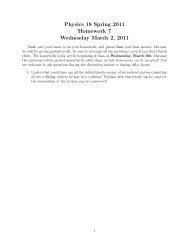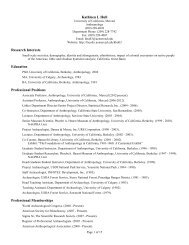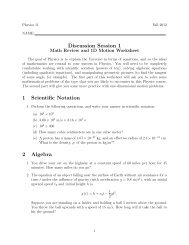Physics 18 Spring 2011 Homework 3 Wednesday February ... - Faculty
Physics 18 Spring 2011 Homework 3 Wednesday February ... - Faculty
Physics 18 Spring 2011 Homework 3 Wednesday February ... - Faculty
Create successful ePaper yourself
Turn your PDF publications into a flip-book with our unique Google optimized e-Paper software.
<strong>Physics</strong> <strong>18</strong> <strong>Spring</strong> <strong>2011</strong><br />
<strong>Homework</strong> 3<br />
<strong>Wednesday</strong> <strong>February</strong> 2, <strong>2011</strong><br />
Make sure your name is on your homework, and please box your final answer. Because<br />
we will be giving partial credit, be sure to attempt all the problems, even if you don’t<br />
finish them. The homework is due at the beginning of class on <strong>Wednesday</strong>, <strong>February</strong><br />
9th. Because the solutions will be posted immediately after class, no late homeworks can<br />
be accepted! You are welcome to ask questions during the discussion session or during office<br />
hours.<br />
1. Astronauts in apparent weightlessness during their stay on the International Space<br />
Station must carefully monitor their masses because significant loss of body mass is<br />
known to cause serious medical problems. Give an example of how you might design<br />
equipment to measure the mass of an astronaut on the orbiting space station.<br />
1
2. A net force of (6.0 N) î − (3.0 N) ˆj acts on a 1.5 kg object. Find the acceleration a.<br />
What is the magnitude of the acceleration, a?<br />
2
3. Seat belts and air bags save lives by reducing the forces exerted on the driver and<br />
passengers in an automobile collision. Cars are designed with a “crumple zone” in the<br />
front of the car. In the event of an impact, the passenger compartment decelerates over<br />
a distance of about 1 m as the front of the car crumples. An occupant restrained by<br />
seat belts and air bags decelerates with the car. By contrast, an unrestrained occupant<br />
keeps moving forward with no loss of speed (Newton’s first law!) until hitting the<br />
dashboard or windshield. These are unyielding surfaces, and the unfortunate occupant<br />
then decelerates over a distance of only about 5 mm.<br />
(a) A 60 kg person is in a head-on collusion. The car’s speed at impact is 15 m/s.<br />
Estimate the net force on the person if he or she is wearing a seat belt and if the<br />
air bag deploys.<br />
(b) Estimate the net force that ultimately stops the person if he or she is not restrained<br />
by a seat belt or air bag.<br />
(c) How do these two forces compare to the person’s weight?<br />
3
4. A 35.0-kg traffic light is supported by<br />
two wires as in the figure. (a) Draw the<br />
light’s free-body diagram and use it to<br />
answer the following question qualitatively:<br />
Is the tension in wire 2 greater<br />
than or less than the tension in wire 1?<br />
(b) Verify your answer by applying Newton’s<br />
laws and solving for the two tensions.<br />
4
5. A 65-kg student weights himself by<br />
standing on a force scale mounted on a<br />
skateboard that is rolling down an incline,<br />
as shown in the figure. Assume there is no<br />
friction so that the force exerted by the<br />
incline on the skateboard is normal to the<br />
incline. What is the reading on the scale<br />
if θ = 30 ◦ ?<br />
5
6. A block of mass m slides across a frictionless<br />
floor and then up a frictionless ramp.<br />
The angle of the ramp θ and the speed of<br />
the block before it starts up the ramp is<br />
v0. The block will slide up to some height<br />
h above the floor before stopping. Show<br />
that h is independent of m and θ by deriving<br />
an expression for h in terms of v0 and g.<br />
6
7. A block of mass m is being lifted vertically by a uniform rope of mass M and length<br />
L. The rope is being pulled upward by a force applied to its top end, and the rope<br />
and block are accelerating upward with an acceleration of magnitude a. Show that<br />
the tension in the rope at a distance x (where x < L) above the block is given by<br />
(a + g) [m + (x/L) M].<br />
7
8. The figure shows a 20-kg block sliding on<br />
a 10-kg block. All surfaces are frictionless<br />
and the pulley is massless and frictionless.<br />
Find the acceleration of each block and<br />
the tension in the string that connects the<br />
blocks.<br />
8
9. A 2.0 kg block rests on a frictionless wedge<br />
that has a 60 ◦ incline and an acceleration<br />
a to the right such that the mass remains<br />
stationary to the wedge. (a) Draw the<br />
free-body diagram of the block and use<br />
it to determine the magnitude of the<br />
acceleration. (b) What would happen<br />
if the wedge were given an acceleration<br />
larger than this value? Smaller than this<br />
value?<br />
9
10. Elvis Presley has supposedly been sighted<br />
numerous times since his death on August<br />
16, 1977. The following is a chart of<br />
what Elvis’s weight would be if here were<br />
sighted on the surfaces of other objects<br />
in our solar system. Use the chart to<br />
determine: (a) Elvis’s mass on Earth, (b)<br />
Elvis’s mass on Pluto, and (c) the free-fall<br />
acceleration on Mars. (d) Compare the<br />
free-fall acceleration on Pluto to the<br />
free-fall acceleration on the moon.<br />
10<br />
Planet Elvis’s Weight (N)<br />
Mercury 431<br />
Venus 1031<br />
Earth 1133<br />
Mars 431<br />
Jupiter 2880<br />
Saturn 1222<br />
Pluto 58<br />
Moon 191


